#hausa dressing
Explore tagged Tumblr posts
Text
men cannot be lesbians. (no im not talking about GNC lesbians) no real lesbian, elder or young, is saying men can be lesbians. gender non conformity has always been apart of lesbian history, and always will be, but not men.
and here are some arguments yall lesbian "men" love:
- "read Stone Butch Blues" Stone Butch Blues was actually NOT about being a man, you read the book instead of repeating misinformation spread by others who also haven't read the book
- "leslie feinberg was a man" so close! ze wasn't a man at all. "I am female-bodied, I am a butch lesbian, a transgender lesbian-referring to me as "she/her" is appropriate, particularly in a non-trans setting in which referring to me as "he" would appear to resolve the social contradiction between my birth sex and gender expression and render my transgender expression invisible." this in no way is saying leslie identified as a man. to finish off this quote: " I like the gender neutral pronoun "ze/hir" because it makes it impossible to hold on to gender/sex/sexuality assumptions about a person you're about to meet or you've just met. And in an all trans setting, referring to me as "he/him" honors my gender expression in the same way that referring to my sister drag queens as "she/her" does." [forgive me if i used 'ze' incorrectly]
- "trans men feel safe in this space, away from xyz" and what about the lesbians who use the lesbian community as a safe space away from men? why do they have to compromise their safe space for the sake of a man?
- "trans men feel an attachment" and that's totally fine! it's okay to feel an attachment to a community you've been apart of for a long time. but there is a difference between attachment and identification. wanting to aide the lesbian community is totally fine, welcomed even! but this does not equate to identification.
- "gender is complex" as someone with a complex gender identity, i agree! but again, i am talking about men 'being' lesbians. not about gnc/gender complex lesbians.
- "it's not your business what a trans person identifies as" when it gets to said person invading my community, they make it my business. the same way it would be if a cis person claimed to be t4t
- https://africasacountry.com/2014/03/africa-has-always-been-more-queer-than-generally-acknowledged "see! it exists outside of america!"
wrong again! "Whereas the term ‘male lesbians’ is an attempt at translating the Hausa (e.g. Northern Nigerian) for ‘passive’ male partners or ‘yan kifi, who have sex with each other, ‘lesbian men’ in Namibia designate women who play the dominant ‘butch’ role in a same-sex relationship. Even though the terms ‘butch’ and ‘femme’ are not known in (Namibian) Damara culture, the various sexual practices and dress codes find some resonance in the admittedly Western butch-femme dyad." as you can see, the term 'lesbian man' is a place holder for the term 'butch' seeing as that term does not exist in those cultures, aka, lesbian 'men' are not a thing and this debate is solely american
I am in no way belittling trans people or the things the trans community has done for the LGBTQ+ community. This post is strictly saying men cannot be lesbians, again, men not gnc lesbians.
20 notes
·
View notes
Text
Hausa traditional dress and culture #Africa
22 notes
·
View notes
Text

A Hausa girl dressed in a Fulani attire, carrying a calabash on her head and ready to head out to to hawk.
------
Directed by: @xamanijnr
Photographed by: Gamaliel Bahago
Modeled by: Maryam Yunusa Zakariyya
Styled by: Uwengkam Mathew
#african#africanfashion#african culture#african history#african recipe#afrikan beauty#fulani#hausa#fura da nono#the sahel cuisine#lorito house#nigeria#nigeriainpictures#nigerianstreet#artfestival#portrait#culture#west africa
2 notes
·
View notes
Text
Will Meghan cosplay traditional Nigerian tribal garb on her visit? What WILL she wear? And how will she do her hair in that challenging climate? by u/Hermes_Blanket
Will Meghan cosplay traditional Nigerian tribal garb on her visit? What WILL she wear? And how will she do her hair in that challenging climate? It will be very interesting to watch Madame's fashions on her visit to Nigeria. Am willing to bet she knows next to nothing about Nigeria's history or people, starting with the fact that there is no such thing as being "43% Nigerian".Nigeria as an entity did not exist until 1914, and did not become an independent country until 1960. It developed from many, many native tribes, and became a multinational state made up of more than 250 different ethic groups, with greatly varying cultures. So Meghan could say she was, say, 43% Hausa or Igbo, but not "Nigerian".But she will merrily ignore this on her visit. Now, will she make a sartorial nod to the country where she is a guest just as the royals do?She could do this by using green and white, the colors of the Nigerian flag, in her clothing. (Oh, the pain of not wearing beige! How will she bear it!) However, with her love of drama, I would be willing to bet she won't be able to resist wearing some sort of traditional tribal garb at least once. Unfortunately, there is no such thing as just "Nigerian" dress. She would have to choose a tribe or at least an area of the country.Here are some of the traditional tribal garments she could choose from. They are historic and beautiful, and I'm dreading to see what she's going to do to them. Also, she may force Harry into tribal dress too, which is not going to go well with red hair and pasty skin. See if you can imagine him in any of these:https://ift.tt/3EmgN8S will she ignore the whole thing and wear expensive wrinkled beige as usual?Then there's her hair. The climate is hot and humid. Will it be all messy bun, all the time? Will it be a head wrap? Will it be a wig? post link: https://ift.tt/sf0KJnv author: Hermes_Blanket submitted: May 06, 2024 at 03:51AM via SaintMeghanMarkle on Reddit disclaimer: all views + opinions expressed by the author of this post, as well as any comments and reblogs, are solely the author's own; they do not necessarily reflect the views of the administrator of this Tumblr blog. For entertainment only.
#SaintMeghanMarkle#harry and meghan#meghan markle#prince harry#fucking grifters#Worldwide Privacy Tour#Instagram loving bitch wife#Backgrid#voetsek meghan#walmart wallis#markled#archewell#archewell foundation#megxit#duke and duchess of sussex#duke of sussex#duchess of sussex#doria ragland#rent a royal#sentebale#clevr blends#lemonada media#archetypes with meghan#invictus#invictus games#Sussex#WAAAGH#american riviera orchard#Hermes_Blanket
6 notes
·
View notes
Text
Yan Daudu
Yan Daudu (singular: Dan Daudu) is group of effeminate homosexual males,drag queens, transgender woman and gender non-confirming in Hausa subculture. Traditionally Hausa culture has acceptance for this queer community, but nowadays Dan Daudu is considered very immoral & shameful in Islamic Hausa communities.
Yan Daudu/Dan Daudu people are born as male, express themselves as woman since very early age. They are often percieved as a gender non-confirming or third gender person in Hausaland. They usually do crossdressing,wear make-up & perform the gender role of opposite gender.
Yan daudu often refers to each other using feminine linguistic forms ( such as feminine names & pronouns). Most of their earning sources are: small business, hair-dressing, prostitution.
Religion
Yan Daudu/Dan Daudu people are associated with a syncretic religious practice that combines elements of Islam & traditional Hausa (Bori) beliefs. However some Yan Daudu may identify as Muslim.They also do Hajj (Islamic pilgrimage) in Mecca.
#africa#african#afro queer#queer africa#gender diverse#gender variance#hausa culture#bori cult#bori religion#hausa queer#homoseuxality
9 notes
·
View notes
Text

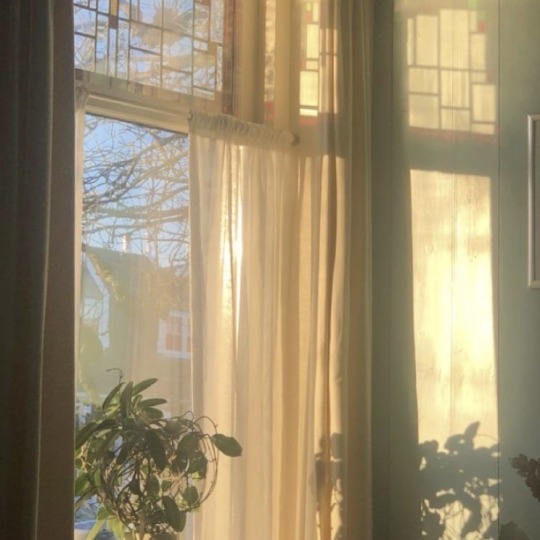
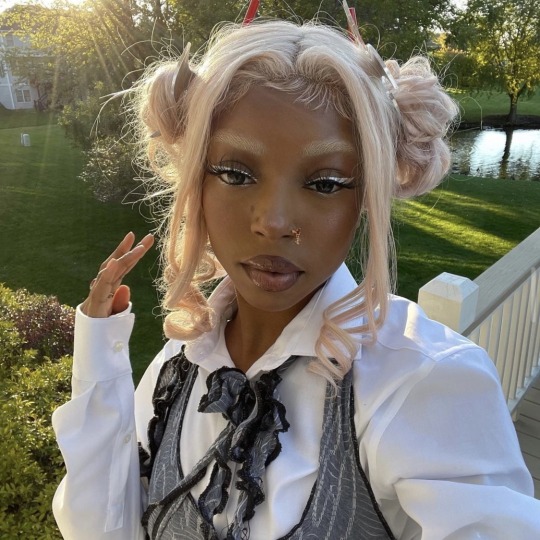
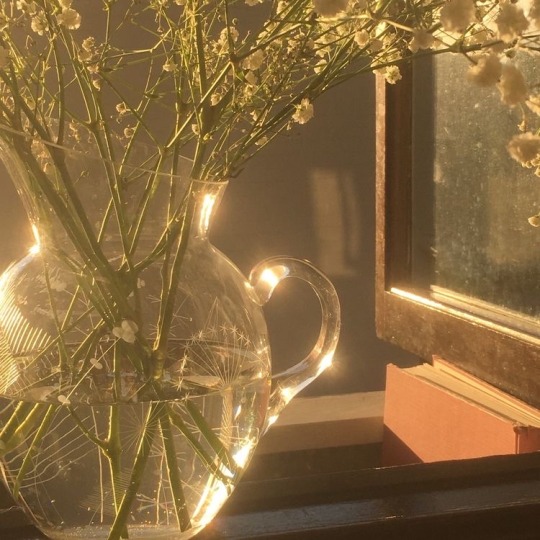

"I like how free light is. I wish to live just as freely as it.~"

:・゚✧:・.☽˚。・゚✧:・.: Marci "Marcia Ngam" Temitope
⋆。°✩ Witch, with medium magic pool, Specializes in Light Magic
⋆。°✩ Can control, create && manipulate all forms && aspects of light, doesn't need light spells or potions
⋆。°✩ Works at a hair salon && specalizes in hair dying along with shorter hair styles
⋆。°✩ Has a Baby Iberian Lynx named Chubs, Caracal named Oranges, && a Silkie Chicken named Fuzz Ball
⋆。°✩ From Aswar, the human equivalent to Chiang Mai, Thailand [Is mixed: Uthax/Lagos, Nigeria [Dad] Aswar/Thailand[Mom]]
⋆。°✩ They/Them | Aromantic [might change], Asexual | 23 years old | 11/21 [Scorpio] | 5’10”
⋆。°✩ They are:
sassy
straight to the point
very straightforward
jokes a lot
fashionable™️
learns kind of quick
Extras
⋆。°✩ only close friends can call them Marcia
⋆。°✩ they don't mind if close friends use she/her pronouns on them
⋆。°✩ natural eye color: white with black specs
⋆。°✩ eyes might change color: very pastel yellow [happy], very pastel pink [anger], very pastel blue [sadness]
⋆。°✩ they get flashes of white light in their eyes when they are curious
⋆。°✩ has dark skin, their eyes seem glassy since they are such a light color half the time, always has a different hairstyle in, has earrings, dresses in a very business casual look, very dramatic or light makeup no inbetween, has natural black hair
⋆。°✩ likes: heels, cats, vests, round glasses, books, the outside, styling hair, makeup, nail polish, sweater vests, fancy trousers, patterns, sandels, the beach, sunlight, refractions of light, dark/light academia, coffee stains on letters, old aged paper
⋆。°✩ dislikes: annoying people, people sassing them back, disrespect, tangled hair
⋆。°✩ languages: english [small african accent], thai, hausa
NSFW
⋆。°✩ Is asexual!! Is not comfortable with sexual advances but doesn't mind friendly kisses to the cheek/forehead/hand/etc. or sex jokes!!
⋆。°✩ uses 🕯️ on dash
Relationship Statuses
⋆。°✩ at the salon && frustrated
⋆。°✩ is aromantic as of now, might change in the furture
⋆。°✩ friends: Lelani [favorite customer 💸], Jay [personal assistant 💈], Jooheon [book club buddy 📚]
⋆。°✩ children: Ace [little baby! 😘], @welcome-to-maniac Jeongin [bread maker 😎]
⋆。°✩ family:
Tags:
⋆。°✩ friend tag(s):
⋆。°✩ family/children tag(s): #✂️little assistant
⋆。°✩ music tag(s): #🎶marci music [music inspo], #🎼character music [all character music inspo]
⋆。°✩ inspo tag(s):
⋆。°✩ other tag(s): #🕯️marci.txt [marci text/interactions]

faceclaim: @/blkkstar on ig
4 notes
·
View notes
Photo
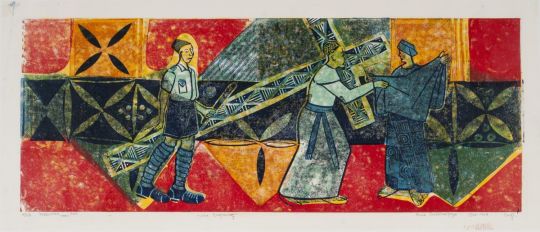
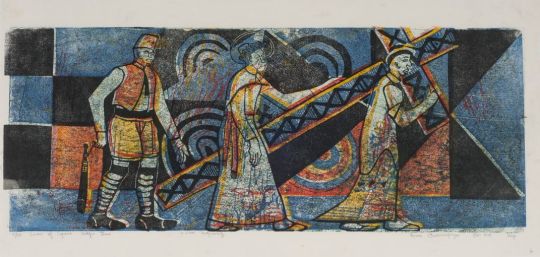
After Nigerian Independence, One Renowned Artist Made Jesus a West African Savior in His Vibrant Work
In the 1960s, a Catholic priest named Father Kevin Carroll approached [Bruce] Onobrakpeya, alongside fellow Nigerian artists, to interpret the Passion of the Christ for local parishioners and Christian converts, highlighted by a series of murals at St. Paul’s Church of Ebute Metta in Lagos.
Instead of reproducing or reappropriating the Western gaze, Onobrakpeya casts Jesus as a West African savior and sets the biblical parables in Nigerian cities, with local architecture and expressive signs of traditional life. In his work, clothing becomes a striking focal point of heritage and agency. As Jesus carries the cross on his relentless trek to Calvary, the women of Jerusalem wear adire, a native brilliantly patterned indigo-dyed fabric; Pontius Pilate appears in royal costume, as a Yoruba or Ghanaian chief in kente cloth; the Nativity shepherds are dressed as members of the Hausa people, an ethnic group in Nigeria and other parts of Africa.
“Certain situations would be completely unknown to us in West Africa,” says Onobrakpeya, a founding member of the Zaria Art Society or the “Zaria Rebels”—a student group in 1958 at the Nigeria College of Arts, Science and Technology famous for blending modernist Western techniques and local art traditions. “For instance, in the interior of the country, you don’t have rivers. You don’t have any water.” An anchor as a biblical metaphor to represent God and faith, he continues, “is difficult for people to understand. So instead of using an anchor, I use a pin that will pin down a tent.”
“The Catholic priests preached goodness. They were agents of development and progress,” he says. “But their mission, apart from teaching, apart from health and so on, was to create a situation whereby the minds of the people were softened to the extent of accommodating all the colonial masters.”
1 note
·
View note
Text
Netizens slam killing of elephant by man in military uniform

A video showing the killing of an elephant in the Kala Barge Local Government Area of Borno State, on Monday, surfaced online. In the video shared by @MusaGwary on the X platform, the man who killed the elephant was alleged to be a military man because he was dressed in military uniform. He was captured in the video shooting the elephant. Another man looked on as the man in military uniform fired at the elephant while another man in a blue shirt was also seen carrying a gun in the video. The men in the video, speaking in Hausa Language had alleged the destruction of their farmland by the elephants.A translation of their claim reads, “This feat we have achieved today, we set out from Gambori, possibly we already came here, we came with our cartridge and everything and we were lucky to have killed two. “If this kind of effort has been made and you kill two, two ten times by now things would have doused because of the destruction they do us. We are happy today and we applaud those who made this effort.” However, the number of men and those in the video cannot be ascertained. The video also shows how the elephant was butchered by the men. Nigerians on the social media platform X have, however, condemned the killing of the elephant. A screenshot of the men butchering the elephantAlso, wildlife lovers have condemned the video and called on the military, and the Borno government to probe the act. Writing on X, a Netizen Gwary said, “Urgent call to end elephant killings in Kala Barge Local Government. Viewer’s discretion is advised. I am writing to bring your attention to a critical issue that demands immediate action – the alarming rate of elephant killings in Kala Barge Local Government. “The majestic elephants, crucial to our ecosystem, are facing a dire threat that requires our collective efforts to address. Let us stand together in the defence of these gentle giants, protecting them from further harm.” Also writing, @inv__Sulaiman called on the customs “to investigate and find this military man and execute him” Another user with the handle @IdakwoJags said, “So meat is now scarce up to the extent of eating elephant” while @AdamAbbaji expressed sadness watching the video. He called on the Borno state government to probe the act. “This is very sad to watch. I hope the Borno State Government will immediately investigate this gruesome tragedy of killing endangered animals,” he expressed. @UsmanZannah decried the increasing rate of killing elephants. He suggested, “Africa demands immediate attention and action from the authority and it necessitates urgent measures to protect them and preserve the ecosystem.” Bashir Ahmad (BashirAhmmad), a former aide to former President, Muhammadu Buhari, reacted by saying, “This is so sad. And they’re even proud of what they did. Haba.” A user, @MalcolmAlkalee, called for the preservation of wildlife so that generations to come can be beneficiaries of it. “Why kill this innocent elephant? In the near future, we have nothing to showcase for the upcoming generations. #PreserveWildLife. @amse48 called for more awareness to protect the wildlife. “This is heartbreaking! We need to raise awareness about this issue and urge the authorities to take immediate action to protect these magnificent creatures.” @Ceasarokoli questioned the use of weapons by the alleged military men. “How can military officers use weapons purchased with taxpayers’ money to kill an elephant? What sort of rubbish is this?” Another, @tawaladeyemi reacted by saying, “Elephants play a vital role in maintaining the ecological balance, and their senseless killing not only poses a threat to their existence but also disrupts the delicate ecosystems they inhabit. I implore the government to take immediate and decisive action to address this issue.” Efforts to speak with the state commissioner for Information and Internal Security, Professor Usman Tar, could not be reached for reaction as of the time of filing this report. Every 3rd of March is marked as World Wildlife Day. It is a United Nations International Day to celebrate all the world’s wild animals and plants and the contribution that they make to human lives and the health of the planet. Read the full article
0 notes
Text
History 101: What it takes to be a MENTALLY ENSLAVED Harlequin in Your ancestral Land.
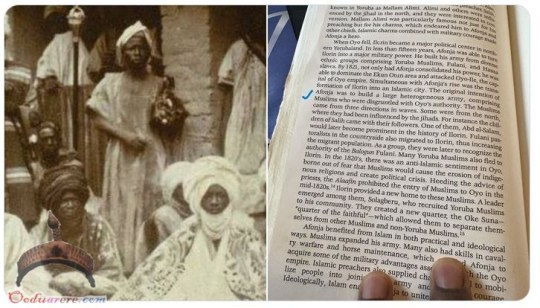
The quote for today is a page from Toyin Falola's book, 'Yoruba Warlords of the 19th Century'. To a lot of Yoruba Muslims. Islam means servitude to Usman Dan Fodio's estate at Sokoto. They indulge in the same idiocy that led to the fall of the great Hausa civilization. Many Yoruba Muslims from Oyo are a dangerously brainwashed set of people that would pose future danger for the preservation of Yorubaland like their ancestors who pledged allegiance to Ilorin and revealed many of the warfare secrets of Oyo. leading to Emir Shitta’s decision to send Jimba. The general of his slave army to Oyo. With the role of confiscating all the Egungun dresses during the reign of Alaafin Amodo. This Egungun mysticism is the secret behind the expansion of Oyo from a boarder post kingdom into the greatest empire of the lower Niger. It was introduced during the reign of Alaafin Ofinran. This was the time the head of the Egugun mysteries called Alapini was added to the Oyomesi. The throne at Sokoto is the origin of many setbacks to Yoruba country.

When Salih, popularly known as Alfa Alimi put plans in place to get rid of Afonja and take the throne of his ancestors. He brought warriors who fought the Jihad at Sokoto. Some of them were led by one of his elderly sons. Abdulsalam, the warlord who would later rise politically at Ilorin to become the first Emir. It was from Ilorin that many invasions into Yoruba heartlands led to the mass capture of Yoruba people who were sold into slavery at the coast. One of the cities razed down at this time was Oshogun and one of the future legends captured from this city was Ajayi Crowther. With all the raiding and capture of Yoruba cities, a portion of the captives were sent to Sokoto as tributes to Sultan Belo. After the visit of Clapperton to Sokoto. with the desire of Europe to have a bilateral relationship with the caliphate. Sultan Belo developed a near obsession for Yorubaland. When his emissaries gave him news of the country. He was amazed. In one of his writings, he wrote that. ‘Yaorubaland is an extensive province containing rivers, forests, sands, and mountains….. Also many great and extraordinary things.' At the battle of Otefan, when Ilorin saw the massive army led by Oluewu and Eleduwe of Bariba to meet the Emir in battle, Shita sent a message to Sokoto for help.
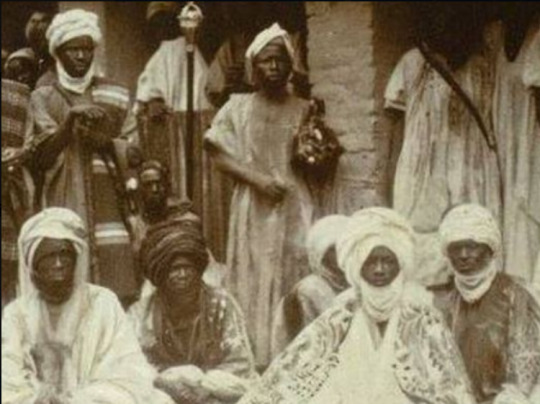
Sultan Belo sent 17 generals from his military base at Rabbah ( the birthplace of Ahmadu Belo, Sadaurna of Sokoto) leading calvary horsemen of close to 100,000 warriors. Thanks to the Military prowess of the Baribas and Oyo warlords, Ilorin was defeated in battle. Ojo Amepo… one of the legendary Kakanfos at Oyo, salvaged the Oyo army and built a coalition army of soldiers from Oyo and Ikoyi. The future great Kakanfo Kurunmi fought under his banner. When he finally fell in battle against the caliphate due to treachery from within, his soldiers dispersed and many of the cities he protected in Yorubaland were evacuated. This was what led to the migration tensions in Yoruba country. the origin of the Ife/Modakeke crisis. Owu/Ibadan tensions. Egba/Ijaye fights and Ibadan/Egba wars. All these tensions resulted from mass migrations from the North, by Yoruba people fleeing from the caliphate. Nigeria today, thorough treachery places the throne of Sokoto as the supreme authority for Islam. This happened during the junta of Babangida. The Kanuri people who are mostly Muslims rejected this. But many Yoruba Muslims. Like the mentally enslaved idiots that they embrace overlords that nearly destroyed their heritage in the name of religion. The cognitive dissonance is why many mentally damaged religious slaves of Abraham do not understand why a man who rates Sokoto above Ife is not fit to rule the Oyo kingdom. Many Hausa people were Muslims when Usman Dan Fodio launched his Jihad. Like the stupid Yoruba people who believe religion over DNA determines brotherhood in nationhood, they fell for a scam and today, they are second-class citizens in their ancestral home. To associate with the very throne that caused so much pain and sorrow to your ancestors in the name of religion is to be a MENTALLY ENSLAVED FOOL. Read the full article
0 notes
Text
Hausa Tailoring Design for Women (Dinkin Atamfa na Mata)
Hausa is one of the majority tribes in Nigeria. They reside in the northern part of the country. They have their unique style of dressing, but we will focus on the women’s style (salo mata). There are different Hausa Tailoring Design for Women in Hausa, Dinkin Atamfa na Mata, and we will be sharing some design photos so you can see the fantastic and beautiful designs. Many Arewa celebrities…

View On WordPress
0 notes
Text
Nigerian Wedding Attire
NIGERIAN WEDDING ATTIRE Igbo | EDO | Hausa | Yoruba Weddings across Africa hold deep cultural significance, and all ethnic groups within Nigeria have their own vibrant and culture-rich way of celebrating the union between families. Even within each ethnic group, there are regional variations in customs and clothing styles. In this article, we will take a look at the traditional ethnic wedding…

View On WordPress
#bini wedding#edo wedding#esan culture#esan groom#esan wedding#hausa bride#hausa dressing#hausa groom#hausa wedding#igbo bride#igbo bride and droom#igbo groom#igbo traditional attire#igbo weddings#nigerian bride#nigerian groom#nigerian wedding#nigerian wedding attire#nigerian wedding ddress#nnewi bride#traditional edo wedding#traditional hausa outfit#yoruba bridal wear#yoruba wedding attire
6 notes
·
View notes
Text


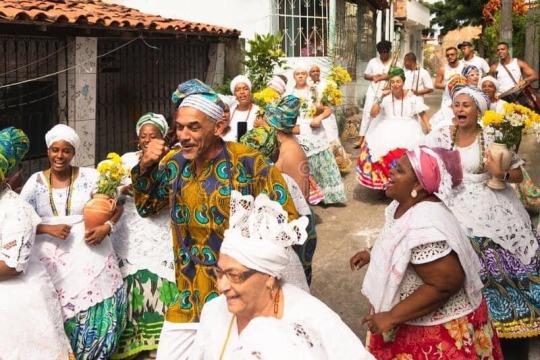
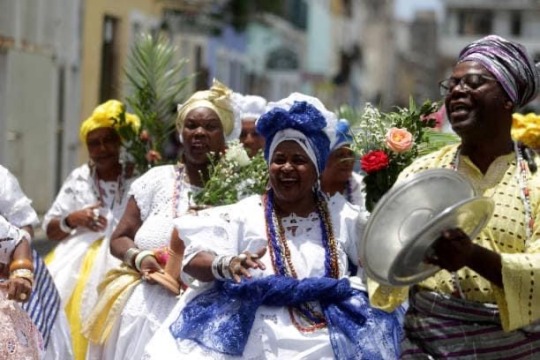

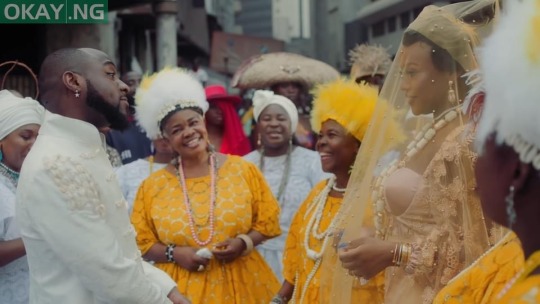

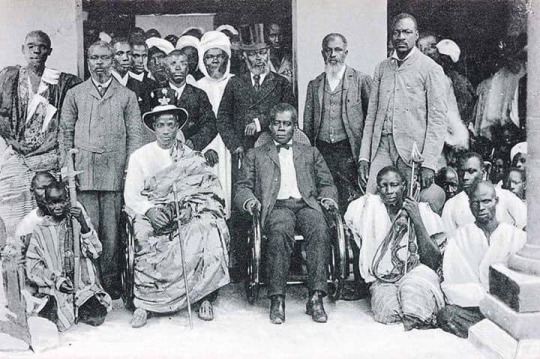
AFRO BRAZILIANS OF NIGERIA
🇳🇬🇧🇷🇳🇬🇧🇷🇳🇬🇧🇷🇳🇬🇧🇷
Brazilians in Nigeria, Amaros or Agudas consist of the descendants of freed Afro-Brazilian slaves who left Brazil and settled in Nigeria. The term Brazilians in Nigeria can also otherwise refer to first generation expatriates from Brazil.
🇧🇷🇳🇬
Starting from the 1830s, many emancipated Africans who had been through forced labour and discrimination in Brazil began moving back to Africa, noteably Nigeria, with the largest number, being in Lagos, while other regions with significant populations were
Lagos, Abeokuta, Ibadan, Warri, Calabar, and Port Harcourt, bringing along with them some cultural and social sensibilities adapted from their sojourn in Brazil. These emancipated Africans were often called "Aguda" or "Amaro", and also included returnees from Cuba. As of today there are less than 200 Brazilian citizens registered within the consulate in Nigeria.
🇳🇬🇧🇷
At the height of the Transatlantic slave trade in West Africa, many prisoners of war or those kidnapped for sale in slave markets were sold to Europeans and transported across the Atlantic. Estimates of the number of slaves from the Gulf of Guinea to Brazil totaled about 300,000 in the nineteenth century. The captives disembarked in Bahia before moving further south to work on plantations, assist tradesmen or hawk goods for white Brazilians. As some gained manumission, earned savings or got deported as a result of racism, waves of African migration back to the West African coast developed. By the middle of the nineteenth century, an Afro-Brazilian community had begun to emerge along the West African coast, developed by descendants of slaves who had twice crossed the Atlantic. These Africans brought back Afro-Brazilian sensibilities in food, agriculture, architecture and religion.
🇧🇷🇳🇬
The first recorded repatriation of African people from Brazil to what is now Nigeria was a government-led deportation in 1835 in the aftermath of a Yoruba and Hausa rebellion in the city of Salvador known as the Malê Revolt. After the rebellion, the Brazilian government - fearful of further insurrection - allowed freed or manumitted Africans the option to return home or keep paying an exorbitant tax to the government. A few Africans who were free and had saved some money were able to return to Africa as a result of the tough conditions, taxation, racism and homesickness. In 1851, 60 Mina Africans put together $4,000 to charter a ship for Badagry.
After slavery was abolished in Cuba and Brazil in 1886 and 1888 respectively, further migration to Lagos continued. Many of the returnees chose to return to Nigeria for cultural, missionary and economic reasons. Many of them descended from the Yoruba. In Lagos, they were given the watery terrains of Popo Aguda as their settlement. By the 1880s, they comprised about 9% of the population of Lagos. Towards the end of 1920, the migration stopped.
🇳🇬🇧🇷
Though coastal Lagos was the preferred destination, most of the returnees were descendants of groups such as Ijeshas, Oyos, Ijebu and Egba based in the interior. The Agudas were aware of their home cities but preferred to set up shop in Lagos because it was conducive for trade, they were warmly received in Badagry and also because of on-going wars in the interior. A ship with Agudas docking in Badagry would be welcomed by crowds of children hailing them as they disembarked from the ship, whereas in the hinterlands strangers were viewed with suspicion. In some cases, the Oba of Lagos gave them land to build a house and provided men to assist them in their transition to local life. This notwithstanding, Lagos was different from Bahia. The elder returnees were comfortable, but many of the children were foreign to Lagos. They held on to elements of Bahia culture such as Catholicism and formed a close knit community within Lagos Island. Because of the retention of Catholicism and Western dressing, indigenous Africans called them "black whites" or Agudas. Keen on acquiring wealth in Africa, some of the earliest Agudas were morally ambivalent on issues such as slavery and became slave traders themselves, such as the descendants of Francisco Felix de Sousa and Domingo Martinez.
Returnees from Brazil and their present-day descendants were and are more commonly called "Agudas" (from agudão, a non-standard Portuguese word for cotton properly rendered as algodão or "Amaro". Most were Catholics, but some worshiped African Orishas which they brought from Brazil. Some of the Agudas are also Muslims. Most of them still have Portuguese names. Some common Portuguese family names in Nigeria include Pinheiro, Da Silveira, De Silva, De Souza, and Moreira. In the 1800s, the major distinguishing set of classification was by birth, Agudas taken captive from West Africa who emigrated back to Lagos were called Papae or Mamae and those who were born in Brazil and then returned were called Yaya or Yayo.
The Brazilians began to cultivate relationships with the traditional authorities in Lagos, while some renewed relationships with Africans in the hinterland by supplying them with weapons. Agudas supplied weapons to the Ijeshas in the war against Ibadan. Beginning in the 1880s, many began to change their names to African ones while the Aurora relief Society was formed to research their culture. The Brazilian's also bought their architectural style of houses, which are still evident in Lagos Island Yaba, Abeokuta, Warri, Port Harcourt and Calabar
Notable Brazilian Nigerians include:
DJ Caise, DJ Xclusive
Adetokunbo Ademola
Adeyemo Alakija
Aduke Alakija
Kojo Annan
Elizabeth Abimbola Awoliyi
Mobolaji Bank Anthony
Bankole Cardoso
Candido Da Rocha
Moses Da Rocha
T.A. Doherty
Bernadine Evaristo
Abimbola Fernandez
Antonio Deinde Fernandez
J.M. Johnson
Jibril Martin
Orlando Martins
Femi Pedro
Joke Silva.
🇧🇷🇳🇬🇧🇷🇳🇬🇧🇷🇳🇬🇧🇷🇳🇬
10 notes
·
View notes
Text
FULANI:
A BRIEF WALK INTO THE ORIGIN AND LIFESTYLE OF THIS BEAUTIFUL PEOPLE

With an estimated amount of 20-25 million, they are believed to come from North Africa and the Middle East.
The Fulani people are one of the largest ethnic groups that can be found widely dispersed across the Sahel and West Africa.
Known by different names across the globe, they are called the Fula people in Manding languages and can sometimes be spelled as ‘Fulah’ or ‘Fullah’.
In French they are called Peul, in the Hausa language they are called Fulani or Hilani; and in Portuguese they are called Fula or Wolof.
However, of all these names ‘Fulbe’ is the preferred name of these group of people. The Fulani’s are located in an area that stretches from Ouaddai, a city east of Lake Chad, to Senegal’s Atlantic shore.
They are as far east as the border of Ethiopia.
The Fula people generally practice Islam, on their way to or back from Mecca, Saudi Arabia, settled in parts of eastern Sudan.
Today, they represent a community known as Fellata.
What is the origin of the Fulani people?
The origin of the Fulani people is debatable, and this is because numerous ideas about their ancestry have been proposed.
But the main religion of the Fulani’s is Islam and the taking on of this religion became a boundary marker.
People whom historians recognize as Fulani today are presumed to have North African or Middle Eastern origin known as ‘white-rooted’ ethnic groups in West Africa, they have a much lighter complexion than most Africans.
These people are the largest nomadic pastoral community and as pastoral people, they tended to move in an eastern direction and spread over much of West Africa.
Movement of the Fula people in West Africa followed a specific pattern.
At first, their relocation was peaceful, but after some time, the Fulani’s became angry and resentful at being ruled by people they deemed as ‘pagans’ or ‘imperfect Muslims’.
Their anger was driven further by the larger migration that took place in the 17th century and the majority of the migrants were Muslims.
By the start of the 18th century, there was a rebellion against local rulers which led to the holy
wars (jihads).
The Situation in Nigeria was a little bit different as they settled in a place that was more evolved and settled that other areas in Western parts of Africa.
And it was during the 15th century they arrived in Nigeria. They settled in Hausa states such as Kano, Zaria, and Katsina as clerics.
Others later settled among local people in the 16th and 17th century, at this time the predominant Hausa state was Gobir after being able to gain its independence from foreign rulers.
Gradually forgetting their own custom, the Fulani people welcomed the ways of the Hausa people and began to fill elite positions in Hausa states, gradually forgetting their own customs; but despite the influence of power, they still had ties to the cattle or bush Fulani.
These ties which they still had, became useful when they joined the jihads which continued with force across West Africa.
Shehu Usman Dan Fodio was an outstanding Fulani cleric. He launched a jihad in 1804 and by 1810 almost all of the Hausa states had been defeated.
The Cattle Fulani were enraged at what they viewed as unfair cattle tax levy imposed on them by the ‘imperfect Muslims’.
After his victory, many Hausa’s such as Yakubu in Bauchi and those in Adamawa joined Usman Dan Fodio.
Fulani marriage
It is a belief among the Fulani’s that marriages are supposed to produce many children, and as a result of this, they marry young without any desire for birth control.
Unlike other African cultures, virginity is not placed on a high pedestal. In fact, women are supposed to bring sexual experience to the marriage.
However, they, on the other hand, are to display modesty when the topic of marriage arises.
During the marriage ceremony, the father of the bride transfers one of his herds to the groom, as a sign of legalizing the marriage.
After this, another ceremony called ‘Kabbal’ may take place and neither the bride or groom is to be present.
Customarily, the status of the bride increases with each child she bears, especially if they are
male.
Fulani’s practice endogamy (The custom of marrying only within the limits of a local community, clan, or tribe).
Fulani food
It is not uncommon to see Fulani women hawking milk products in decorated calabash on their heads.
Fresh milk is termed ‘Kossam’ and yoghurt ‘
Other meals include Nyiri which is heavy grease made of flour and is eaten with soups (Takai,
Haako) which is made from tomatoes, peppers, and other vegetables.
Another popular meal is fermented milk with corn couscous which is referred to as ‘latchiiri’ or ‘dakkere’, it could also be taken as a fluid called ‘gari’ which is made of flour cereals.
On special and specific occasions they eat meat. Milk, goat cheese and millet with dates are pounded together to produce a thick beverage.
Fulani mode of dressing
Their mode of dressing depends on the region they come from. The Fulbe Wodabaabe wear long flowing embroidered or decorated robes which are always very colorful.
In central Guinea, the men wear hats with colorful embroidery, whereas in Nigeria, Cameroon, and Niger, both men and women wear a typical white or black cotton material gown, embellished with blue, red and green thread embroidery work.
The style varies with sex and region.
The men wear a hat that tappers at 3 angular tips and it is called ‘noppiire’.
Women decorate their hair with beads and cowrie shells, they also decorate their hands, arms, and feet with henna (Lali).
Fulani men wear solid colored shirts and trousers which go down to their lower calves, they carry walking sticks across their shoulders with their arms resting on them.
A typical Fulani can be easily identified by markings on his/her face; around their eyes, mouth, and foreheads for men.
7 notes
·
View notes
Text

AFRICAN BARBER SURGEONS 💈 : MORE THAN A HAIRCUT
Up until the 19th century barbers were generally referred to as barber-surgeons, and they were called upon to perform a wide variety of tasks. They treated and extracted teeth, branded slaves, created ritual tattoos or scars (Tribal marks), cut out gallstones and hangnails, set fractures, gave enemas, and lanced abscesses. Whereas physicians of their age examined urine or studied the stars to determine a patient’s diagnosis, barber-surgeons experienced their patients up close and personal. Black barber-surgeons also provided the only medical service that Africans received aboard slave ships, since the “surgeons” who made the crossings to and from africa were often slaved barber-surgeons forced to work on slaveships by their masters. They were more than likely rented or leased to the ship Capt or company.
Kongo/Angola slaves and freemen dominated the barbering trade in South Carolina, New York, And other places in the diaspora, performing the same tasks as free barbers: shaving, dressing hair, and setting wigs. They also worked as personal body servants and were employed in shops owned by their slave masters. In Bahia, between 1741 and 1749 all 38 barbers were of African descent — 17 slaves and 21 free blacks or mulatos . The techniques of cupping and blistering was also practiced in Africa by Hausa barber-surgeons (Imperato, 17). Barber-surgeons occupied a unique position and constituted a significant part of the male ex-slave population. Despite the fact that full-time slave barber-surgeons were only about one percent of the whole male slave population, barber-surgeons constituted surgeons represented 6.3 percent of the African-born freedmen in Conceição da Praia parish (1843).
Nishida, Mieko. Slavery and identity: ethnicity, gender, and race in Salvador, Brazil, 1808-1888. Indiana University Press, 2003.
Karasch, Mary C. "Slave life in Rio de Janeiro, 1808-1850." (1973): 2288-2288.
Klein, Herbert S., and Ben Vinson III. African slavery in Latin America and the Caribbean. Oxford University Press, 2007.
Ottenheimer, Harriet. "Africanisms in American Culture edited by Joseph E. Holloway." (1991): 33-34.
4 notes
·
View notes
Text
“Clean Our Toilets and Take Our Germs to Your Church!” Muslim Persecution of Christians, March 2020
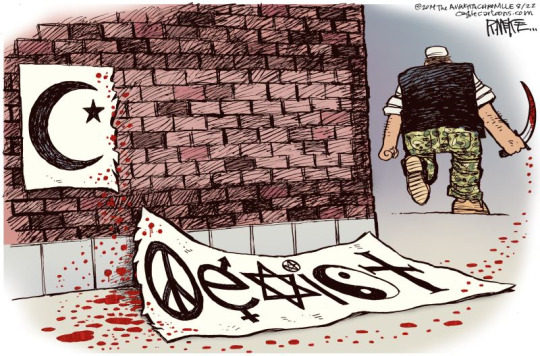
by Raymond Ibrahim
The following are some of the abuses Muslims inflicted on Christians throughout the month of March, 2020, thematically arranged:
The Kidnap, Rape, and Forced Conversion of Christians
Pakistan: A group of motorcycle-riding Muslim men kidnapped and gang raped two 12-year-old Christian boys. The children were playing video games at a local arcade when a gang of Muslims approached and lured them to check out and eventually sit on their motorcycles. Once the boys were atop the vehicles, the men rode off to a remote field where “the young boys were beaten till they submitted to the demands of the Muslim men, at which point the 12 year olds were raped,” notes the March 23 report:
After the ordeal Suneel and Harry [the two boys] were threatened not to say anything by the gang as they rode off … leaving the boys behind naked. Suneel and Harry then tearfully and in pain got dressed and walked for 3 hours till home. Suneel managed to stagger home at 3:30 am early the following morning and was received by his father Naeem (40 yrs) who had not slept all night. Naeem and other family members were praying for Suneel and were shocked when they found him crying and trembling with fear.
Last reported and according to his mother:
Suneel is not eating properly. He cries all the time and has said he does not want to go to a local school. Other boys have been teasing him and it has created a dark sorrow within him. We cannot take him to church as they are all closed [due to COVID-19] and he is slowly entering a deep depression.
Separately, on March 1, two Muslim men abducted a 13-year-old Christian girl, forcibly converted her to embrace Islam, and married her off to a Muslim. Saima Javid was kidnapped while fetching water from a pump near her home. “I was deeply depressed and thought of committing suicide when I lost my daughter,” her mother said while discussing this incident. “Young Christian girls are not safe in this country. Muslims consider them as their property or slaves and therefore humiliate them as they wish.” After confirming that “our daughters are often sexually harassed by influential Muslims,” the girl’s father added that “The police did not listen to us for five days. However, when news of the abduction went viral on social media, the police registered a First Information Report (FIR # 137/20) against the abductors on March 5.” As a result, on March 26, the 13-year-old Christian girl appeared in court where she “testified that she had been abducted and was forced to convert to Islam and forced to marry [a Muslim man].” The judge ordered her returned to her family. “This order marks a rare victory for Pakistani Christians affected by the issue of abduction, forced conversion, and forced marriage,” the report correctly observes.
Nigeria: On March 12, the Hausa Christian Foundation of Nigeria announced that a young girl named Sadiya Amos had managed to escape from her Muslim kidnappers. The girl was originally abducted in early January; she was subsequently forcibly converted to Islam and married off to one of her kidnappers. Sadiya was thereafter kept in a small room under guard. One day, the guards fell asleep without locking her room. She managed to sneak out and flee back to her family’s home—only to find her father experiencing his own problems for trying to rescue her: a Sharia court was accusing him of trying to prevent his daughter from embracing Islam—and had even produced a forged certificate to that effect—in an effort to assist her abductors. The statement adds that,
The case of abducting Christian Girls and their forceful conversion to Islam as well as forcing them into marriage has become a water shed issue in Northern Nigeria…. The moment these girls are abducted, they are subjected to all manners of evil just to take control of their minds. Once they took hold of their minds, these girls will only do everything they are asked to do. While the parents fight for the release of their daughters, these abductors continue to sexually abuse these girls, hypnotized [subliminally influencing?] their food, drinks, clothes, where they sleep, perpetually evoke evil spirit upon them to the point that these girls completely lost their minds and never think of going back to their home. Usually, the moment a Christian girl is abducted they ensure that they get married to her within one or two weeks. She will be sexually abused even before the marriage to make the parents give up on her when she becomes pregnant.
Egypt: An unknown woman posing as a Coptic nun, along with an unknown man posing as her monk assistant, were exposed as frauds who were using their religious garb to target and lure young and trusting Christian girls. The issue was apparently serious enough for the Coptic pope himself to make a statement disavowing the two charlatans. On social media, the “nun,” known only as Theodora, had a photo shopped picture of herself with the pope. It is unclear what the exact scam was—whether it was for later extortion or identifying potential kidnapping victims. Elaborate schemes to target Christian girls in Egypt are not uncommon.
The Slaughter of Christians
Nigeria: According to a March 8 report titled, “Nigeria: A Killing Field of Defenseless Christians,”
Available statistics have shown that between 11,500 and 12,000 Christian deaths were recorded in the past 57 months or since June 2015 when the present central [Muhammadu Buhari-led] government of Nigeria came on board. Out of this figure, Jihadist Fulani herdsmen accounted for 7,400 Christian deaths, Boko Haram 4,000 and the “Highway Bandits” 150-200.
According to numerous Christian leaders in Nigeria, the reason formerly simple Fulani herdsmen have managed to kill nearly twice as many Christians as the “professional” terrorists of Boku Haram is because one of their fellow tribesmen, the president of the nation, Muhammadu Buhari, is enabling their jihad.
Kenya: On March 11, Muslims connected with the Islamic terror group, Al Shabaab (“the Youth”) killed two more Christians and abducted a third in yet another roadside ambush. In the first instance, a passenger bus was stopped and stormed by the terrorists, who proceeded to order all the passengers out. “They abducted the only Christian on the bus, the mechanic, and allowed the others to continue with their journey,” a police officer reported. The second attack occurred an hour later in the same region. Two medical transporters—both Christians—delivering much needed medicine to Mandera, which has suffered much from ongoing Al Shabaab violence, were stopped in their truck; they were “killed by shooting and their bodies dumped on the roadside,” an official confirmed. In the previous three months, at least 13 other Christians were killed under nearly identical circumstances in Kenya—yanked out of ambushed vehicles and slaughtered on being identified as Christian.
Pakistan: More details concerning the February 28 torture and murder of Saleem Masih, a Christian farm laborer who dared use water from the same well used by Muslims emerged in a March 3 report: When his tormentors first gathered around and starting beating and kicking him, “they called him chura (filthy Christian cleaner), while making him lick their boots telling him kaffir (non-Muslim) dogs deserve such treatment.” They then dragged him by the hair and chained him in a barn where the torture began in earnest: they “rolled a thick iron rod across the whole of Saleem’s body which by now had many fractures and internal injuries. Saleem was tortured and spat at for at least 4 hours until he went unconscious.” The report concludes by quoting Juliet Chowdhry, a Pakistani human rights activist in the UK:
A senseless violent attack has ended the life of a young Christian man, left a mother and father heart-broken and community beleaguered. The men who undertook the attack are so blinded by hate they are showing no evidence of remorse. Overcoming such hate will take a miracle as it is ingrained into every aspect of culture and society in Pakistan and is reinforced via a biased national curriculum. It will take decades to remove such entrenched intolerance and I fear I will not see it in my lifetime…. Nations such as the UK naively continue to send foreign aid to Pakistan despite the existing social malaise – this naive attitude contributes to Pak-Government apathy and perpetuates the status quo.
The Jihad on Churches
Norway: A Muslim migrant set fire to two churches. According to the March 21 report, the man, aged 28, from a Middle Eastern or African nation, torched the churches in “revenge” for some unclear but supposedly “blasphemous” treatment of the Koran at the hands of a Norwegian. He was imprisoned for four weeks, which the court said was “not disproportionate,” as “it is a serious crime.”
United Kingdom: A 23-year-old man who was initially only described as a “Norwegian”—but who was later revealed as a Muslim born to Somali refugees—was arrested for plotting to bomb St. Paul’s Cathedral in London. “Based on the material we seized and reviewed, we believe that he may be suspected of having participated in the terror organization Islamic State,” police added. He is also accused of managing to destroy evidence in a still-in-progress terrorism case in Denmark. According to the March 23 report, his co-conspirator and fellow arrestee, Safiyya Amira Shaikh, a British woman born as Michelle Ramsden who converted to Islam in 2007, admitted to the planned terror attack: “the goal was to kill as many people as possible in a suicide bomb attack on St. Paul.” Earlier, in an encrypted chat with an undercover police officer, Safiyya had said that she would “rather die young and get to Jannah (paradise) the quickest way possible… I always know I wanted to do something big… killing one kafir (infidel) is not enough for me.” She had further expressed a desire to target a church on a Christmas or Easter day, when they would be packed, to kill more people.
Sudan: Unknown militants burned down two churches in the Muslim majority nation. According to a March 18 report from Dabanga, an independent Sudanese news outlet,
[V]iolence against Christian communities has continued, despite the changes that have occurred in Sudan over the last year… [T]he first attack took place … in Omdurman on Saturday February 29. A church building of the Sudanese Church of Christ was torched. It is not known who the perpetrators are. The second incident occurred on March 9, when militants set fire to the Presbyterian Evangelical Church in Bout, El Tadamon local in Blue Nile state. The church was destroyed completely, including the furniture and books within it.
Counting these latest, five churches have been torched in Sudan since the start of 2020.
Indonesia: Around mid-March, authorities closed down another church in response to ongoing protests by the Islamic Defenders Alliance, a Muslim advocacy group—even though the building had been used as a church between 2017 and 2020. Initially, local Muslims had complained that it had a visible cross, which the congregation quickly removed. However, that was not enough, and the Islamic Defenders Alliance issued a statement saying, “We, from the alliance, demand that the church be demolished as soon as possible.” Since Muslims first began protesting the existence of the church, its pastor has tried to find a new place to build a new church, but has been unsuccessful, as local residents reject having a church near them. “Many Christians across Indonesia face religious persecution that is embedded in the culture and legal system,” said another March report: “Christianity, both Protestants and Catholics, make up 10% of the population. That’s close to 26 million people that are being affected by this discrimination.”
Pakistan: A Muslim man beat “to near death” his Christian servant for threatening to quit unless permitted to attend church. Shaan Masih, 21, had never wanted to follow in his father’s footsteps and be a household servant to the wealthy and influential Muslim but was pressured into it after his father died. Shaan “was working from 7am to 7pm every day and suffered a lot of bullying at work, was pushed and beaten,” the report explains. “He was constantly called a Chura (dirty Christian cleaner) and soon cleaning toilets became a regular part of his work despite his protestations” that his original contract stipulated that he would not clean toilets. Only he, the report adds, “was required to clean the toilets and none of the Muslim servants,” who “were also treated with more respect.” On March 13, after Shaan asked his employer’s wife if he could leave a little early so he could attend evening mass at church, she exclaimed, “You Chura are always going to those dirty churches and bringing your germs into our home! Before you go, clean our toilets and take our germs to your church so that they can suffer instead.” Shaan refused: “Being before God is a sacred thing and I want to be comfortable with God and would not feel good, if I clean your toilets before I go.” When she threatened to fire him, he said he quit and went straight to church; when he returned home, his Muslim boss called and asked him to come and collect his things and get paid. Shaan “was really pleased about this as he had waited so long for the payment and was beginning to feel pressure from a large number of growing debts.” According to the report, when he arrived,
Kashif [the boss] and other servants were waiting for Shaan with a hot iron rod and leather belt. Shaan was resoundly [sic] beaten, spat at and tortured for at least 20 minutes by the family members of Kashif and his servants… While he was beaten Kashif berated Shaan for leaving his place of work without express permission from him: ‘You are a Chura and should not leave a Muslim masters premises until told to. Your nerve to stand up to Muslims is a blasphemy and I will kill you for this!’ Kashif ran inside his home to grab a gun and shoot Shaan who was by now terrified and in fear for his life.
A servant helped Shaan to escape during the commotion; he “sped towards his home bleeding along the route.” When a relative opened the door, “he collapsed on the floor” and his mother “began screaming in a panic…. Shaan fell unconscious for several hours from the pain of his injuries.” “The attitude of both the police and medical staff was really disappointing,” Shaan later said in an interview, regarding how both had ignored his pleas for justice and help. “Despite severe burns on my body and immense pain, they treated me like an animal.” According to his mother, “He used my son like a donkey, never paid him and then enacted such violence for no reason. I fear he can kill my son anytime he wants because of his influence and power.”
Turkey: The desecration of Christian cemeteries, many of which are attached to churches, is on the rise. According to a March 14 report, 20 of 72 gravestones in the Ortaköy Christian Cemetery in Ankara were found destroyed. “These attacks against cemeteries are making the Christian community across Turkey feel incredibly sad and desperate,” an Ankara-based pastor observed: “Nobody can watch over the graves of their loved ones like a guard.” In one instance, the desecraters broke a cross off a recently deceased women’s grave in a church cemetery; days earlier, her burial service was interrupted by cries of “Allahu Akbar!” “My son lies here,” another Christian woman explained: “He died last year. He was 17-years-old. Children his age came here and destroyed his grave. What type of conscience can accept this?… If my son were alive, he would not do such a thing. They have carried out similar attacks before, and no one was caught.” An “environment of hate” for Christians is behind this upsurge, said one local journalist:
But this hateful environment did not emerge out of nowhere. The seeds of this hatred are spread, beginning at primary schools, through books printed by the Ministry of National Education portraying Christians as enemies and traitors. The indoctrination continues through newspapers and television channels in line with state policies. And of course, the sermons at mosques and talk at coffee houses further stir up this hatred.
Pakistan: A March 1 report offered more details on the February 2 shooting and axe attack on Christians for daring to build a church on their land. According to the wife of Azeem Masih (32), who was shot in the head and has lost the ability to speak and other functions:
We were all asleep at 11 pm, as Azeem is a tailor and had to work from early in the morning. Suddenly we heard an evil-sounding cacophony of shouts. Some of the local community including Azeem went out of the house to see what was happening – other[s] were dragged out by a local Muslim gang that had gathered around the Christian properties. The men seemed intent to harm all the Christians; they were threatening to rape all the Christian women and beat and kill all other Christians. I was shuddering with fear. I got on my knees and prayed and then heard gunshots. After this people could be heard running and screaming. Someone told me Azeem had been shot, I ran to him and at first I thought he was dead. I sat their weeping until the police arrived and took us to hospital. I am heartbroken. Azeem and I have only recently had a child and he has hardly got to know Tabeel. Now I do not know if he will ever be able to speak to Tabeel again. I am not used to seeing Azeem like this; he has become so dependent on others, whereas he was always the first to help them. Azeem was a healthy and committed husband and father—a man of God who wanted to strengthen the church with a new building. I cannot understand why these men have acted so violently, as they were not provoked by us—we have tried to live peaceful lives.
COVID-19 Discrimination in Pakistan
Christians and other “infidels” were discriminated against and denied the same aid given to Muslims in response to the COVID-19 pandemic. According to a March 30 report:
A Karachi NGO has denied food aid to poor Hindus and Christians, who like Muslims are suffering from coronavirus…. The Saylani Welfare International Trust has been operating in the Korangi area since 1999, handing out aid and meals to homeless people and seasonal workers. Two days ago, the welfare organisation refused to give ration cards to non-Muslims, saying that only Muslims are entitled to them. The reason for this is that Zakat, Islamic alms giving (one of Islam’s five pillars), is reserved for Muslims. The Christian man said he begged for food to no avail. Farooq Masih, a 54-year-old Christian in Korangi, said that last Saturday, Abid Qadri, a member of Saylani Welfare, with other NGO members, handed out food cards in his area. But, when they got to Christian homes, they just moved on.
“A few days back there was an announcement made through a mosque’s loud speaker in the Sher-Shah neighborhood of Lahore inviting citizens to collect the government’s announced foodstuffs,” a pastor explained concerning another similar incident. “When Christians reached the distribution point and presented their national identity cards, they were asked by staffers to get out of the line claiming the foodstuff was only for Muslim citizens.” This same pastor received numerous phone calls from his flock, all of whom experienced the same denial. “Christians often face religious hatred and discrimination,” a Christian woman, aged 50, said of her experience. “However, we never thought of this biased behavior by the majority people at this critical time of COVID-19.”
Raymond Ibrahim, author of the recent book, Sword and Scimitar, Fourteen Centuries of War between Islam and the West, is a Distinguished Senior Fellow at the Gatestone Institute, a Shillman Fellow at the David Horowitz Freedom Center, and a Judith Rosen Friedman Fellow at the Middle East Forum.
About this Series
The persecution of Christians in the Islamic world has become endemic. Accordingly, “Muslim Persecution of Christians” was developed in 2011 to collate some—by no means all—of the instances of persecution that occur or are reported each month. It serves two purposes:
1) To document that which the mainstream media does not: the habitual, if not chronic, persecution of Christians.
2) To show that such persecution is not “random,” but systematic and interrelated—that it is rooted in a worldview inspired by Islamic Sharia.
Accordingly, whatever the anecdote of persecution, it typically fits under a specific theme, including hatred for churches and other Christian symbols; apostasy, blasphemy, and proselytism laws that criminalize and sometimes punish with death those who “offend” Islam; sexual abuse of Christian women; forced conversions to Islam; theft and plunder in lieu of jizya (financial tribute expected from non-Muslims); overall expectations for Christians to behave like cowed dhimmis, or second-class, “tolerated” citizens; and simple violence and murder. Sometimes it is a combination thereof.
Because these accounts of persecution span different ethnicities, languages, and locales—from Morocco in the West, to Indonesia in the East—it should be clear that one thing alone binds them: Islam—whether the strict application of Islamic Sharia law, or the supremacist culture born of it.
Previous Reports at link below.
7 notes
·
View notes